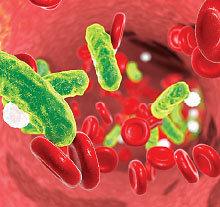Journal Digest
Exposure to Efavirenz in Utero May Slow Development

Despite the antiretroviral efavirenz being recommended as the first-line choice for women with HIV who may have children, few studies have looked at the long-term effects of exposure to the medication on offspring. A study appearing in Translational Psychiatry now suggests that animals exposed to efavirenz in utero may experience changes in brain structure and developmental delays.
Researchers at Radbound University in the Netherlands treated pregnant rats with either 100 mg/kg of efavirenz or placebo (four animals in each group) throughout pregnancy and the first seven days after birth of their pups. The male offspring from each group of mothers were then tested on various physical and behavioral tasks during their youth, adolescence, and adulthood.
The various test results showed that while rats exposed to efavirenz perinatally had reduced body weight and delays in the development of their reflexes and motor skills, anxiety and depression behaviors were similar between the two groups. Brain tissue samples taken from the offspring when they were adults revealed that efavirenz-exposed animals had fewer neurons in regions involved in motor development compared with control animals.
The researchers noted that the mother rats given efavirenz did not show any reduced quality of maternal care, so this was not a factor in the developmental delays.
“Our findings underline the need for long-term clinical studies in children that are perinatally exposed to EFV [efavirenz], as well as more detailed studies on the underlying neurodevelopmental mechanisms,” the researchers wrote.
Wijer LV, Garcia LP, Hanswijk SI, et al. Neurodevelopmental and Behavioral Consequences of Perinatal Exposure to the HIV Drug Efavirenz in a Rodent Model. Transl Psychiatry.. 2019; 9(1): 84.
Nut-Rich Diet Linked to Lower Depression Levels

People who consume a diet rich in tree nuts, particularly walnuts, may have lower levels of depressive symptoms compared with those who do not consume nuts, according to a report from researchers at the University of California, Los Angeles.
The researchers analyzed data from the National Health and Nutrition Examination Survey (NHANES) from 2005 to 2014. For NHANES, participants provided detailed dietary intake information and were also assessed for depressive symptoms with the nine-item Patient Health Questionnaire (PHQ-9). The researchers focused solely on adult NHANES participants (aged 18 and older), resulting in a sample size of 26,656 participants.
On average, the PHQ-9 scores of participants who consumed nuts were 3.82 while those who did not eat nuts had scores of 4.15—a statistically significant difference between the groups. Further analysis showed that people who included walnuts in their diet had PHQ-9 scores of 3.28, whereas people who ate nuts other than walnuts had scores of 3.83. The association between nut consumption and lower depression scores was stronger for women than men.
In looking at responses to individual PHQ-9 questions, the main reasons that contributed to lower depressive symptom scores were that nut consumers reported higher energy levels, had greater interest in activities, and better concentration.
As with any large data analysis, the researchers tried to adjust for other possible contributing factors but acknowledged that other dietary traits of people who eat nuts might help lower depressive symptoms. They also noted that the average scores indicated mild depressive symptoms, so it is unknown whether nuts are protective against major depressive disorder.
The findings were published in the journal Nutrients.
Arab L, Guo R, Elashoff D. Lower Depression Scores Among Walnut Consumers in NHANES. Nutrients.. 2019; 11(2): E275.
Chronic Inflammation Increases Risk of Cognitive Problems

Middle-aged adults with chronic inflammation are at greater risk of cognitive problems as they age compared with those without chronic inflammation, suggests a study published in the journal Neurology. Chronic inflammation is a persistent state of pain and stiffness seen in disorders such as arthritis and multiple sclerosis.
These findings were uncovered as part of the Atherosclerosis Risk in Communities (ARIC) Study. For this large study, all participants had blood tests taken that measured the following inflammation biomarkers: factor VIII, fibrinogen, von Willebrand factor (vWF), and total white blood cell (WBC) count. Three years later, the researchers measured levels of C-reactive protein (CRP), another blood biomarker of inflammation. The participants received cognitive assessments at the beginning of the study, six to nine years later, and at the end of the study.
The participants whose inflammation biomarker score (compiled by adding the values of factor VIII, fibrinogen, vWF, and WBCs) was in the top quartile had a 7.8 percent steeper decline in their cognitive ability over the 20-year period than those in the lowest quartile. The participants in the top quartile of CRP levels had an 11.6 percent steeper decline compared with those in the lowest quartile of CRP levels. Elevated midlife inflammatory markers were most consistently associated with declines in memory.
“Overall, the additional change in thinking and memory skills associated with chronic inflammation was modest, but it was greater than what has been seen previously associated with high blood pressure in middle age,” said lead author Keenan Walker, Ph.D., of Johns Hopkins University in a press release.
Walker KA, Gottesman RF, Wu A, et al. Systemic Inflammation During Midlife and Cognitive Change Over 20 Years: The ARIC Study. Neurology. February 13, 2019. [Epub ahead of print]
School Exclusion More Predictive of Substance Use Than Juvenile Arrests

Research has shown that youth with legal/disciplinary problems are at elevated risk of substance use disorders later in life. A study appearing in the journal Justice Quarterly suggests youth who are suspended or expelled from school may be at greater risk of later substance use than those who are arrested.
A pair of researchers from George Mason University and the University of Florida examined data from the Rochester Youth Developmental Study—a long-term study of youth examining the causes and consequences of delinquency and drug use. The study sample included 960 adolescents who were all enrolled in school at baseline; among this group, about 55 percent were at some point suspended or expelled from school, 18 percent were arrested as adolescents, and 30 percent used drugs during adolescence.
The researchers found that in both the short term and long-term, only school exclusion practices, and not teen arrests, were statistically associated with subsequent substance use. There was a cumulative effect, in that each additional school exclusion increased the likelihood of drug use by about 14 percent. This association was slightly higher in minority students.
“Our findings have important implications for school policies regarding the use of exclusion from school as a disciplinary measure,” the authors wrote. “While no one would deny the need to protect other students and the general academic setting from disruptive and potentially violent behavior, excluding the child from school, even on a temporary basis has been shown to have unintended problematic consequences.”
Dong B and Krohn D. Sent Home Versus Being Arrested: The Relative Influence of School and Police Intervention on Drug Use. Justice Quarterly. February 5, 2019. [Epub ahead of print]
Fluvoxamine Reduces Sepsis Symptoms in Mice

The antidepressant fluvoxamine may be able to reduce symptoms of sepsis (an inflammatory overreaction to infection that starts damaging the host’s body), according to a recent animal study. Sepsis is currently treated with antibiotics to halt the underlying infection, but there are no treatments that directly target the problematic inflammation.
Researchers from the University of Virginia hypothesized that the endoplasmic reticulum (ER)—a component of cells known to affect inflammation—might play an important role in sepsis. They selected an ER protein called the sigma-1 receptor (S1R) as the likely mediator; S1R regulates the production of inflammatory chemicals called cytokines and this receptor is a known target for many drugs. Mice genetically modified to lack S1R were more vulnerable to developing sepsis and more likely to die from septic shock.
The researchers next gave normal mice an acute infection to trigger sepsis and then injected them with either fluvoxamine or saline after they showed signs of sickness; fluvoxamine was selected since this drug binds S1R and stimulates its activity. The animals given fluvoxamine had lower inflammatory cytokine production and had increased survival compared with the animals given saline.
The researchers also found that fluvoxamine could inhibit cytokine production in human blood cells. While additional studies are needed, the findings “suggest that repurposing fluvoxamine to enhance sigma-1 activity may be beneficial for treating sepsis,” the authors wrote.
This study was published in Science Translational Medicine. ■
Rosen DA, Seki SM, Fernández-Castañeda A, et al. Modulation of the Sigma-1 Receptor-IRE1 Pathway Is Beneficial in Preclinical Models of Inflammation and Sepsis. Sci Transl Med. 2019; 11(478): eaau5266.



